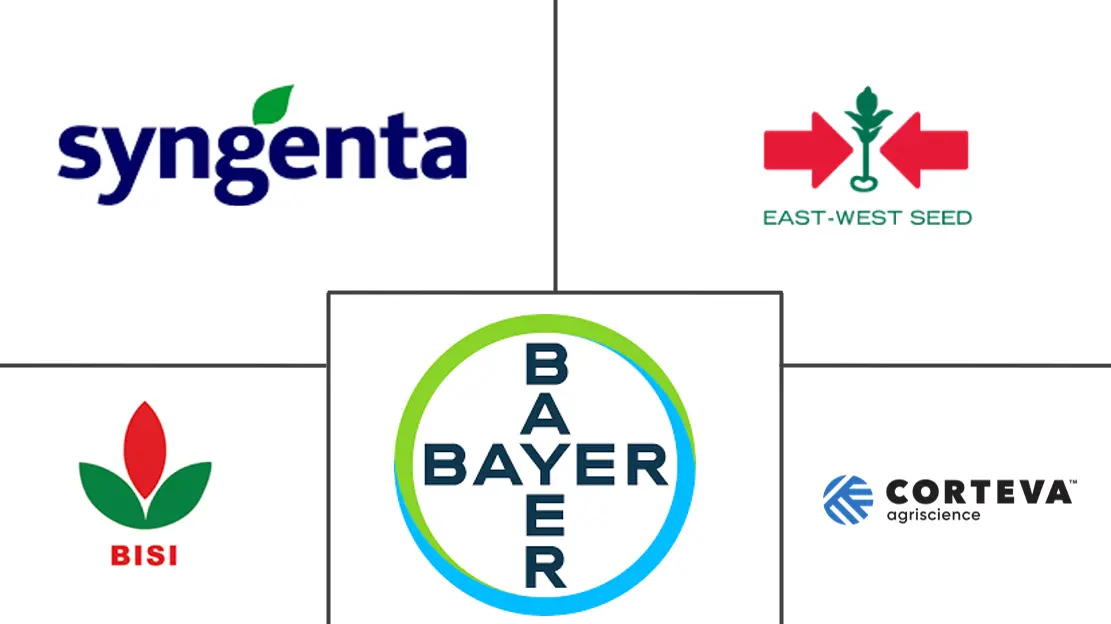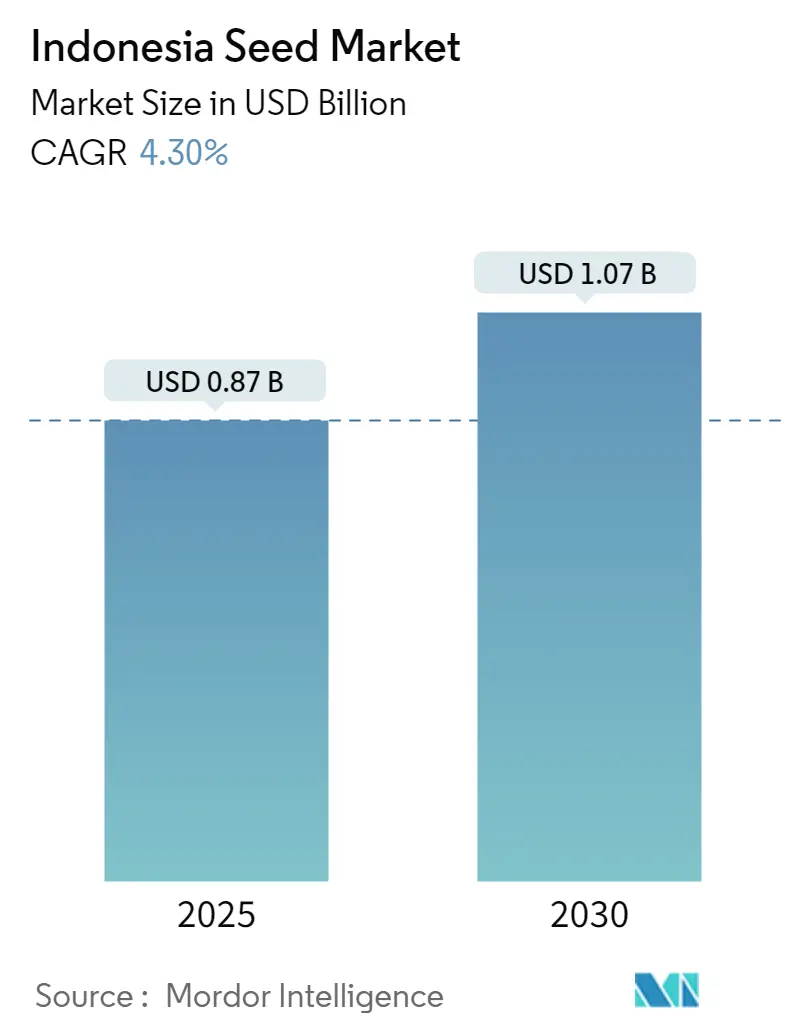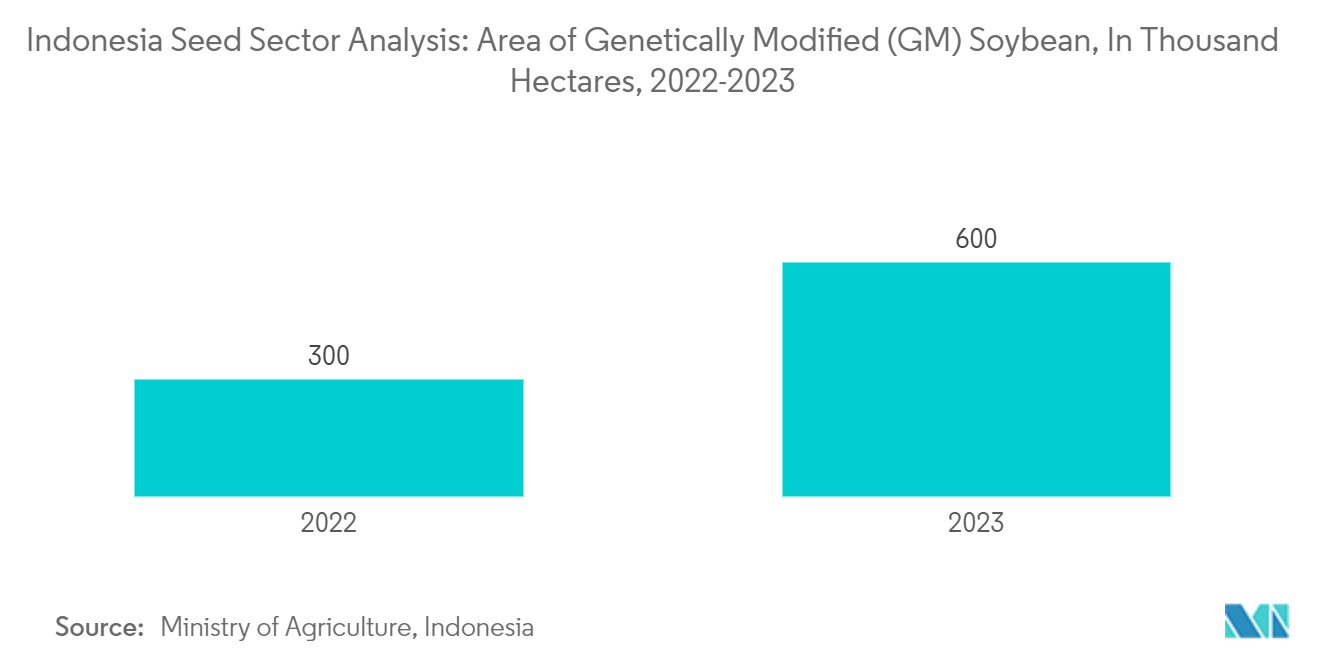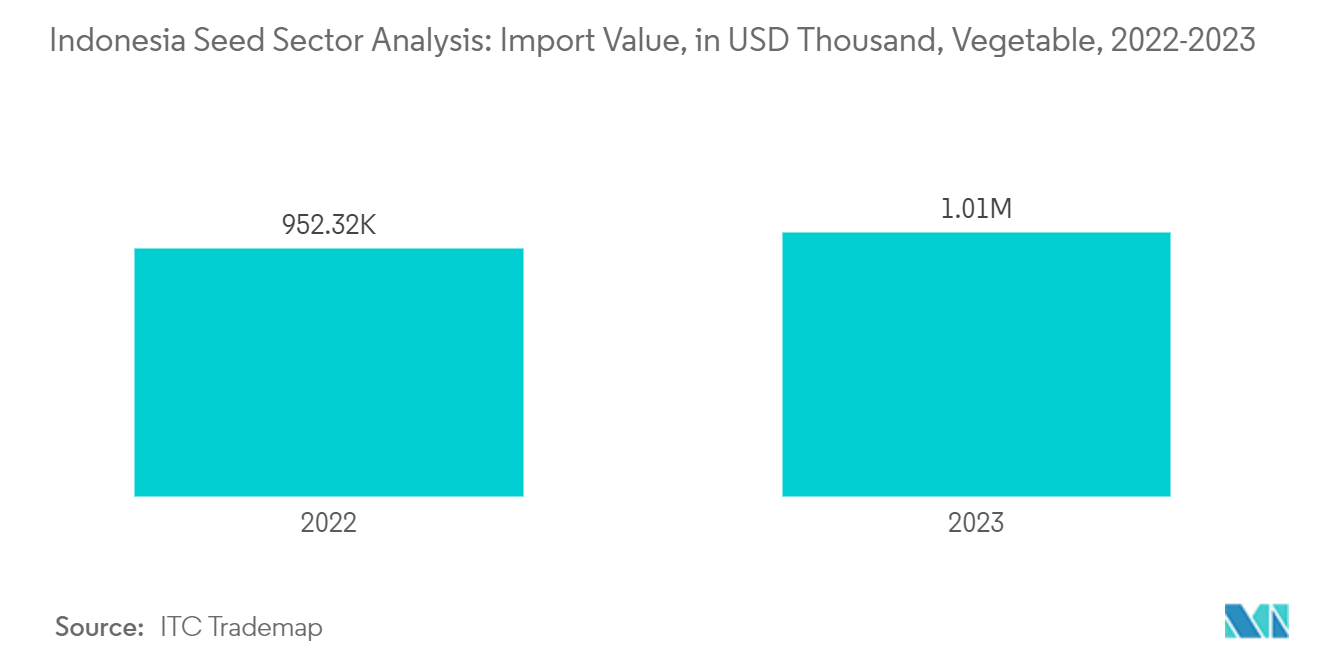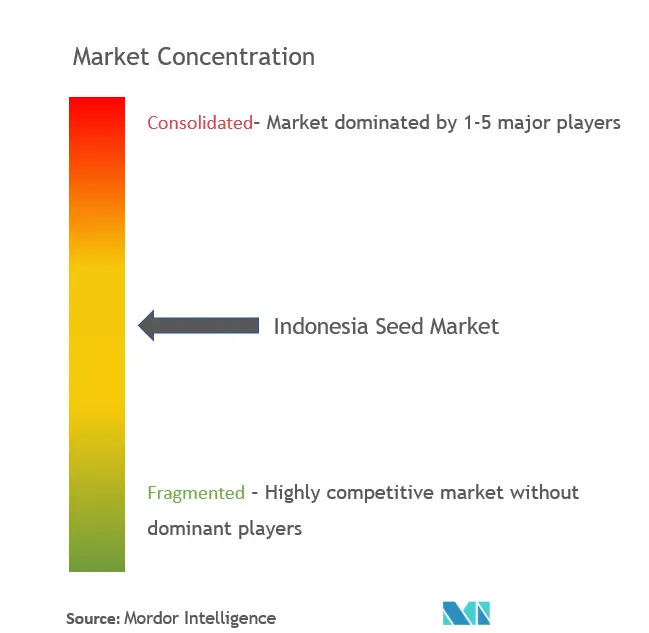Indonesia Seed Market Analysis
The Indonesia Seed Market size is estimated at USD 0.87 billion in 2025, and is expected to reach USD 1.07 billion by 2030, at a CAGR of 4.3% during the forecast period (2025-2030).
Rice is a pivotal staple in Indonesia, significantly influencing the nation's economy. As farmers increasingly recognize the advantages of certified seeds, the demand for these quality seeds is set to surge, promising higher crop yields in the coming years. This growing demand reflects farmers' readiness to invest more in superior seeds. With per capita arable land diminishing, farmers are turning to high-yielding and hybrid seed varieties to boost profitability. Consequently, there's a marked shift among Indonesian farmers from traditional farm-saved seeds to premium packaged seeds, all in pursuit of enhanced returns.
As per the 2023 Indonesia Grain and Feed Annual Report by the USDA, Java accounted for 50% to 55% of the nation's rice production. Sumatra and Sulawesi followed, contributing 20% and 12%, respectively. Notably, about 85% of this rice was cultivated in irrigated paddy fields, hinting at a growing potential for high-yield seed varieties in the future.
Moreover, with opportunities to cultivate corn in the second and third cycles, driven by lucrative corn prices and the adoption of high-yield varieties, projections for 2022-2023 showed corn cultivation to span 3.95 million ha, yielding 12.9 million metric tons. This surge in production, coupled with expanded wet mill capacities and the establishment of new ethanol plants, elevated corn imports to 1.2 million metric tons during 2022-2023, up from 1.165 million metric tons in the previous year.
Additionally, major companies and government entities are bolstering distribution efforts in the seed market, fueling its expansion. For example, in June 2023, the Ministry of Agriculture rolled out 4 metric tons of a new superior rice seed across multiple provinces, including South Sumatra, Lampung, Banten, West Java, Central Java, East Java, South Sulawesi, and West Sumatra. The diverse rice seed varieties distributed include Inpago 9, Inpago 12, Inpago 13 Foriz, Cakrabuana, and Inpari 42. Consequently, heightened awareness of certified seeds, bolstered by increased investments in seed innovations, government backing, and the diverse product offerings of companies, are expected to propel market growth during the forecast period.
Indonesia Seed Market Trends
Increase in Demand for Feed Grains Boosting the Market
Advancements in seed technology, including the development of genetically modified seeds and increased hybridization rates, have bolstered the seed industry's growth. For example, in August 2023, PT. Bayer Indonesia introduced the herbicide-tolerant genetically modified corn variety Dekalb DK95R in Banggo Village, Indonesia. This new variety has the potential to boost yields by up to 30% over conventional methods. Genetically modified (GM) seeds have proven advantageous, enhancing crop yields and fostering resilient varieties. The integration of gene modification in these seeds has not only improved yields but also propelled the growth of the GM seed market. For the first time, Indonesia's Ministry of Agriculture (MOA) has introduced post-monitoring guidelines for the commercial cultivation of genetically engineered (GE) crops under Regulation No. 50/2020.
In 2021, Indonesia greenlit the planting of GE drought-resistant sugarcane, a product of collaboration between state-owned PTPN 11 and Jember University. However, this was restricted to PTPN 11's land, with no seeds available to other farmers and a potential reach of 30,000 ha. In September 2022, the Indonesian government, alongside the Ministry of Economic Affairs, urged farmers to adopt superior genetically modified (GM) soybean varieties to bolster national food security. The initiative aims to entice soybean farmers back to soybean cultivation, having previously shifted to maize. The adoption of GM soybeans could elevate yields from 1.6 to 2 metric tons per ha to an impressive 3.5 to 4 metric tons. Consequently, as farmers increasingly adopt seed technologies and companies innovate with genetically modified varieties, the seed market in Indonesia is poised for growth during the forecast period.
Rising Import of Vegetables Driving the Market
The domestic demand for vegetables in Indonesia is outpacing the supply, leading to increased imports from countries like China, India, Thailand, and New Zealand, accounting for 74.1%, 5.9%, 3.2%, and 3.1%, respectively, in 2023. Fresh vegetable imports from these countries are majorly utilized in horticulture satiation in the country as the locally grown varieties lack quality compared to the international competitors. Expanding this consumption further paves the way for seed breeders to capture the untapped seed market.
The Indonesian government has aimed to shorten the distribution channels by allowing farmers to sell their products directly in the markets, thereby enhancing the local production of quality vegetables. Furthermore, the demand for horticulture products from middle-income families is rising, challenging the inconsistent domestic supply and poor management facilities in horticulture production. According to ITC Trademap, the import volume of vegetables in Indonesia increased from USD 977,240 thousand in 2021 to USD 1,013,897 thousand in 2023.
Indonesia Seed Industry Overview
The Indonesian seed market is consolidated, with key players accounting for most of the market share. Some notable players operating in the market include PT Bayer Indonesia, PT BISI International Tbk, Syngenta, PT Corteva Agriscience, and PT East West Seed Indonesia. These companies are involved in various strategic activities such as product innovation, expansion, and partnership. Mergers and acquisitions are another prominent strategy to expand geographical reach by acquiring other companies' assets, technologies, and consumer base.
Indonesia Seed Market Leaders
-
PT. Bayer Indonesia
-
Syngenta
-
PT BISI International Tbk
-
PT Corteva Agriscience
-
PT East West Seed Indonesia
- *Disclaimer: Major Players sorted in no particular order
Indonesia Seed Market News
- August 2023: PT Bayer Indonesia launched the herbicide-tolerant biotech corn Dekalb DK95R in Banggo village, Manggalewa district, Dompu Regency, West Nusa Tenggara, Indonesia.
- May 2023: Syngenta Seeds collaborated with Wilmar PADI Indonesia and the National Research and Innovation Agency (BRIN) to develop the Witagen rice variety, a high-quality, superior rice seed.
Indonesia Seed Industry Segmentation
A seed is a fertilized mature ovule consisting of the embryo, stored material, and protective coats for crop production. The Indonesian seed sector report is segmented by crop type into row crops and vegetables and product into non-GM/hybrid seeds, GM seeds, and varietal seeds. The report offers market estimation and forecasts in value (USD) and volume (metric tons) for the segments mentioned above.
| By Crop Type | Row Crops | Rice | |
| Maize | |||
| Soybean | |||
| Groundnut | |||
| Other Row Crops | |||
| Vegetables | Chilli | ||
| Onion | |||
| Cabbage | |||
| Tomato | |||
| Other Vegetables | |||
| By Product | Non-GM/Hybrid Seeds | ||
| GM Seeds | |||
| Varietal Seeds | |||
Indonesia Seed Market Research FAQs
How big is the Indonesia Seed Market?
The Indonesia Seed Market size is expected to reach USD 0.87 billion in 2025 and grow at a CAGR of 4.30% to reach USD 1.07 billion by 2030.
What is the current Indonesia Seed Market size?
In 2025, the Indonesia Seed Market size is expected to reach USD 0.87 billion.
Who are the key players in Indonesia Seed Market?
PT. Bayer Indonesia, Syngenta, PT BISI International Tbk, PT Corteva Agriscience and PT East West Seed Indonesia are the major companies operating in the Indonesia Seed Market.
What years does this Indonesia Seed Market cover, and what was the market size in 2024?
In 2024, the Indonesia Seed Market size was estimated at USD 0.83 billion. The report covers the Indonesia Seed Market historical market size for years: 2019, 2020, 2021, 2022, 2023 and 2024. The report also forecasts the Indonesia Seed Market size for years: 2025, 2026, 2027, 2028, 2029 and 2030.
Our Best Selling Reports
Indonesia Seeds Industry Report
Statistics for the 2025 Indonesia Seed market share, size and revenue growth rate, created by Mordor Intelligence™ Industry Reports. Indonesia Seed analysis includes a market forecast outlook for 2025 to 2030 and historical overview. Get a sample of this industry analysis as a free report PDF download.

